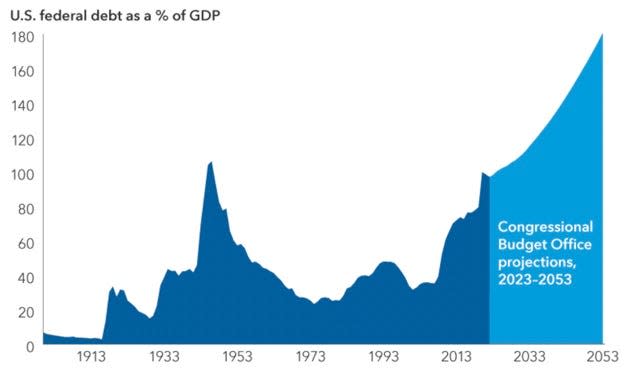The US debt mountain is growing so fast the government could soon be spending more on interest payments than on defense

[ad_1]

-
The US’s mountain of debt has become a cause of concern for investors this year.
-
The government is likely to spend more on interest payments than on defense over the next five years, per Capital Group.
-
The ballooning debt burden could eventually chip away at the demand for Treasury bonds, according to the investment manager.
The US’s mountain of debt is growing every day – and the government could soon be spending more on interest payments than on defense, according to Capital Group.
“US debt dynamics are evolving in a way that requires attention,” Darrell Spence, an economist for the US asset manager, said in a research note back in October. “Over the next five years, net interest payments on the debt are expected to surpass defense spending.”
Spence added that if the world’s largest economy’s debt pile rises at the rate expected by the Congressional Budget Office, the government’s spending on net interest payments could rise from under $500 billion to a staggering $1.4 trillion by 2033.

The idea that interest payments could soon surpass defense spending could be a source of concern for policymakers, with President Joe Biden pledging Monday to ask Congress for over $100 billion worth of funding to support both Israel and Ukraine.
Debt has emerged as a major concern for Wall Street this year, with lawmakers reaching an 11th-hour deal to raise the government borrowing limit back in May and Treasury bonds suffering a rout that ranks amongst the worst sell-offs in market history.
The US government’s liabilities breached an eye-watering $33 trillion on September 18 — a month later, the figure had jumped $33.64 trillion, implying an average daily increase of $20 billion.
America’s borrowings be approaching levels that could cause economic distress, according to Spence.
Typically, a country’s debt levels become a problem if it “had interest rates that were higher than its economic growth rate, the incremental revenue generated by the economy each year became smaller than the interest payments on the debt, and the debt began to grow all by itself,” he wrote.
“The US had been far from reaching that threshold. Until now,” he added.
Spence warned that the ballooning debt pile could force the government to raise taxes, fuel further bond sell-offs, and force the Federal Reserve to lock in higher interest rates.
“Slower economic growth also could be expected, given that government spending would need to be re-routed to debt service,” he added. “For investors, this could lead to lower stock market returns over time, given the strong long-term correlation between GDP growth and market returns.”
This article was originally published on October 20, 2023.
Read the original article on Business Insider
Source link




